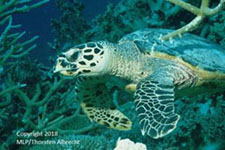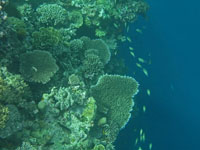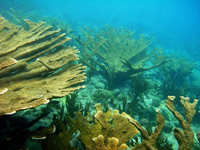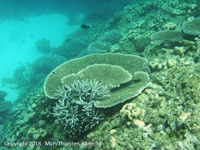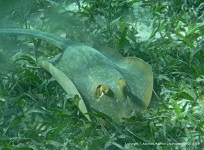Seagrass Meadows
 |
||
| Wakatobi National Park, South East Sulawesi, Indonesia | A closer look into a seagrass meadow often reveals hidden wildlife! |
Seagrass meadows are a marine ecosystem of still widely underestimated importance: They help maintaining a rich marine biodiversity where they occur, they help consolidating sandy and muddy seabottoms against being shifted by water movements, and they are effective 'carbon sinks', their efficiency in absorbing carbon dioxide is higher than the efficiency of tropical rainforests, making seagrass meadows an important ally against human-induced climate change. Seagrasses are no algae, they are higher plants with leaves and roots and develop small white or yellowish flowers.
 |
| Credit: Marco Fusi and Daniele Daffonchio | CC BY 4.0 |
Like all plants, seagrasses produce a part of their nutrients (carbohydrates) by photosynthesis, the other part is taken in via their roots. Their dependence on photosynthesis is the main reason why you won't find seagrass deeper than 35 - 40 metres of water depth, there's simply not enough light available.
 |
| Credit: Cullen-Unsworth L., Jones B., Lilley R. and Unsworth R. | CC BY 4.0 |
Seagrass meadows grow by rhizome extension, which is a relatively fast form of growth, but it is not the only way seagrasses reproduce. Reproducing by rhizomes means that all new plants that grow out of the horizontal stem in the sea bottom are genetically the same plant.
 |
| Public domain picture, downloaded from Wikipedia |
Aside from their non-sexual vegetative propagation by rhizome extension, seagrasses also reproduce by a sexual mechanism, the same as used by plants on land: They develop flowers, underwater flowers! Seagrass plants can be monoecious or dioecious. Monoecious seagrass species have both male and female flowers on the same shoot or lateral shoots of the same plant. Dioecious seagrasses are those that have either male or female flowers borne on separate plants (Japar Sidik Bujang; Muta Harah, Zakaria; Aziz, Arshad; Shiau Lee, Lam; et al.; Flowers and sexes in Malaysian seagrasses [2006]).
Pollination and fertilization happen in the water, the fertilized female flower develops into a fruit.
The fruit separate from their seagrass plant, drift on the surface starting photosynthesis and develop into seedlings, then they sink down to the bottom where they anchor in the substrate.
 |
| Sexual recruitment stages of Posidonia oceanica Credit:Laura Guerrero-Meseguer, Carlos Sanz-Lázaro and Arnaldo Marín | CC BY-SA 4.0 |
Global distribution of seagrass species diversity: The region of richest diversity is (almost) identical with the Coral Triangle, followed by three other regions which also have a quite large variety of seagrasses: West Australia, southern Japan (Ryukyu Islands), many coastlines around India, and the East African coast from northern Mozambique to Kenya. Under the following link you can find a quite detailed species biodiversity map of seagrasses: Seagrass and Seagrass Beds - Scroll down to subchapter Where are Seagrasses found?; Smithsonian Ocean Institute; USA
Posidonia oceanica, the famous Neptune grass, is a larger species of seagrass and endemic to the Mediterranean Sea where it forms large seagrass meadows at water depths of 1 m - 35 m, depending on water clarity at the specific location.
 |
| School of fish above P. oceanica meadow, France Credit: Photo 113968936 | Posidonia Oceanica © Seadam | Dreamstime.com |
Link to an overview of the status of Posidonia oceanica in 2017 on MedWet - The Mediterranean Wetlands Initiative's website: https://medwet.org/2017/10/mediterranean-posidonia/
Ecological importance of seagrass for other marine life: Seagrass meadows are important feeding and breeding grounds for a large variety of fish species, green turtles (Chelonia mydas, they are herbivores when adult), dugongs and manatees graze on them.
 |
| Green turtle feeding on seagrass, Akumal Bay, Mexico Credit: P.Lindgren | CC BY-SA 3.0, Wikimedia Commons |
Richard K. F. Unsworth investigated the seagrass meadows of Wakatobi around the time the national park was established (2002) and found a total of 188 fish species in them, belonging to 46 different fish families, amongst them were 15 different species of Apogonidae (cardinalfishes), 17 species of Labridae (wrasses), 8 species of Mullidae (goatfish), 20 species of Pomacentridae (damselfish)
4 species of Scaridae (parrotfish), 2 species of Serranidae (groupers) and 6 species of Siganidae (rabbitfish), to mention some examples of his fish observation record.
Seagrass meadows are used by different fish species for different ecological functions, classified for Indonesian seagrass meadows as 1. permanent seagrass residents, 2. permanent residents that spawn outside the seagrass, 3. juvenile seagrass residents, and 4. transients or residents seeking food and shelter. The seagrass meadows of Wakatobi are dominated by two seagrass species: Thalassia hemprichii (a smaller seagrass species) and Enhalus acoroides (a larger seagrass species). (Richard K.F. Unsworth)
Prior to this investigation, a total of 360 fish species were recorded in four separate studies in Indonesia between 1977 and 1991. An example from Africa: Gell and Whittington (2002) found 249 different fish species from 62 families within the seagrass meadows of northern Mozambique.
(Source: Julian Clifton/Richard K.F. Unsworth/David J. Smith; Marine Research and Conservation in the Coral Triangle: The Wakatobi National Park; Nova Science Publishers, New York, 2010)
We visited Wakatobi National Park in 2018, here's a small gallery of pictures we shot in the seagrass meadow directly in front of Wakatobi Dive Resort:
 |
||
 |
 |
|
 |
| White-spotted rabbitfish (Siganus canaliculatus) on feeding tour. Their colour pattern is perfectly adapted to seagrass meadows, giving them the right kind of camouflage. |
Link to MUI's seagrass conservation page: SEAGRASS CONSERVATION
Link to BLUE's Maldives project: Blue Marine Foundation - Maldives
MUI also surveyed fish species in Maldivian seagrass meadows, this project was the very first of its kind in the Maldives: They identified 141 different fish species from 31 families in three seagrass meadows in Laamu Atoll.
Here are some of our own pictures from Maldivian seagrass meadows, the second and third showing two selected fish species we observed in the lagoon of Coco Palm Dhuni Kolhu (Coco Collection) in Baa Atoll in January 2019:
 |
 |
 |
||
| Seagrass meadow at Coco Palm Dhuni Kolhu | Yellowfin Surgeonfish (Acanthurus xanthopterus) on feeding tour | A group of humpback unicornfish (Naso brachycentron) |
Apart from fish, seagrass meadows are home to a large variety of invertebrates, bigger and smaller. We can't mention them all, but we want to highlight those that live on seagrass plants, feeding on epiphytes that grow on the seagrass leaves. You will find some high quality pictures of a few of them under the following link:
Seagrass and Seagrass Beds - Scroll down to subchapter Foundation of Coastal Food Webs; Smithsonian Ocean Institute; USAFor those who want to read more about seagrass meadows in general: Secret Gardens Under the Sea: What are Seagrass Meadows and Why are They Important? (Published February 2018)
Seagrass meadows are endangered! Their annual global loss is around 7 %. We must see that we establish better protection measures for this ecosystem in many countries and also use existing possibilities of seagrass meadow restoration!
